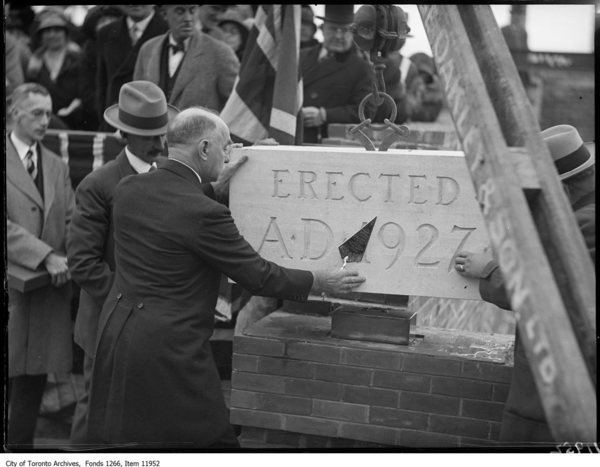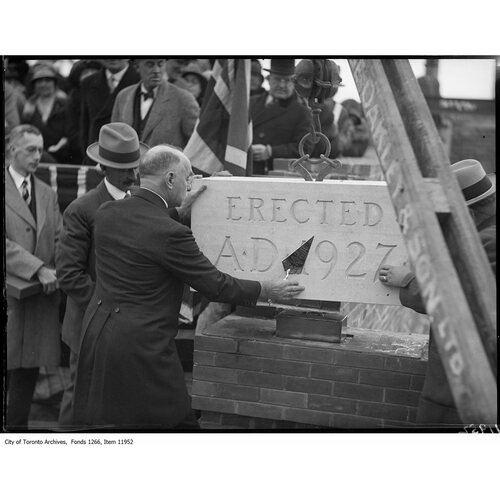
Source: Link
BREDIN, MARK, baker, businessman, and politician; b. 2 July 1863, probably in Dublin, son of John Bredin and Mary Graham; m. 11 Aug. 1885 Eliza Jane Wilcox (1867–1966), a native Ontarian, in Toronto, and they had nine daughters, two of whom did not survive childhood, and at least five sons; d. there 19 Oct. 1935 and was buried in Mount Pleasant Cemetery.
Mark Bredin was 20 years old when he immigrated with members of his family to Canada, arriving in October 1883. In Ireland he had been an apprentice in a bakery; in Toronto he found employment as a bread-wagon driver, worked his way up to baker, and established his own bread-making business on 1 April 1887. By then he was a family man, with a wife and daughter.
Bredin was quick to adopt new bread-making technologies. By one account, in 1891 he was one of a handful of Toronto bakers to possess a mechanical dough mixer, and seven years later he became one of the first bakers on the continent to own a moulding machine. Throughout his career Bredin would develop and market new types of breads. In a 1934 speech to fellow bakers he would argue that providing “good quality goods, and good service at a fair price,” rather than attempting to appeal to customers through cheap prices, was essential to success in the baking industry. “We know it takes courage at times to ask the right price for a good loaf,” he declared, “but the man who has the foresight and gumption enough to take the public into his confidence will eventually reap the benefits of his business courage.”
In 1896 Bredin and local businessman Joseph Tait began manufacturing bread, cakes, and biscuits under the name of the Tait-Bredin Company, with Tait serving as president and Bredin as secretary-treasurer and manager. In 1900–1 rumours circulated that Tait-Bredin would sell out to prominent Toronto baker George Weston* as part of what the Globe deemed an attempt to obtain a monopoly in the city through the creation of a “bread trust.” Amid accusations in the press of unfair business practices, Tait, who had been less involved in the company since entering the Ontario civil service in 1897, claimed that merger talks had been held without his knowledge. Weston replied with a flat denial that such talks had occurred; Bredin does not seem to have spoken publicly about the matter. Tait and Bredin evidently dissolved their partnership since in December 1901 the company was renamed the Bredin Bread Company. Bredin’s brother William James is listed as president in the 1902 city directory, but Mark, as secretary-treasurer, was the dominant figure in the business, whose brand became locally popular. The firm’s best-known loaf was its heavily promoted Cream Bread. Said by the company to be the product of technologically advanced manufacturing methods, it was praised in advertisements for its nutritive value, quality ingredients, and affordability.
It may be that the idea of a merger continued to appeal to Bredin, and there was interest as well from other bakers in the dominion. In 1911 Bredin, Weston, Henry Charles Tomlin of Toronto, William James Boyd of Winnipeg, and Enoch James Stuart of Montreal combined their infrastructure and assets to form the Canada Bread Company Limited. The consolidated enterprise was coordinated and underwritten by Toronto financier Cawthra Mulock*. Bredin was named vice-president and general manager, at an annual salary of $12,000. By its own estimate, the new company could produce 600,000 loaves of bread a week nationwide. Rather than being labelled a combine that restricted competition, the firm was lauded by the press. This changed attitude may have been a consequence of increasing acceptance of the scientific-management ideas of American engineer Frederick Winslow Taylor. The new organization was seen as one that could employ the latest production techniques and achieve the highest possible sanitary standards. According to the Globe, the ultimate goal of the merger was to establish modern bakeries in all of the country’s large cities, which would allow Canada Bread to “deliver a bread of uniform high-grade quality to consumers at the minimum cost.” In 1918, following Mulock’s untimely death, Bredin was named president. Under his leadership the firm became one of the largest bakeries in the country, with vertical integration being a key element in its success. As of 1 July 1922 its profits were $478,657, and a year later the figure had climbed to $711,696. He relinquished his position as general manager in 1925 to his son William Thomas but briefly resumed the role in 1928, after his son’s resignation. That year Bredin retired from Canada Bread and began operating a separate bakery with his sons. By then the Maple Leaf Milling Company, the forerunner of Maple Leaf Foods, had acquired control of Canada Bread, whose brand name and products would still be popular with Canadian consumers in the early 21st century.
Bredin, like other prosperous businessmen of the time, was involved in several concerns, being a director of the United Empire Bank of Canada and board chairman of Canadian Canners. He also entered politics, winning election to Toronto’s city council in 1908. He represented Ward 3 along with future mayor Samuel McBride and cartoonist John Wilson Bengough*. During his two one-year terms as an alderman, Bredin does not appear to have championed any major initiatives or become involved in any significant controversies. Federally, he supported Sir Wilfrid Laurier*’s Liberal Party and was occasionally seen at campaign rallies. During the First World War, however, Bredin, whose son William was an officer in the Canadian Expeditionary Force, publicly backed the Union government of Sir Robert Laird Borden.
Bredin, who occupied an elevated position in Toronto society, was involved in numerous professional organizations and charitable bodies. He was a life governor of the American Bakers Association, head of the Canada Bread and Cake Bakers’ Association, founding board president and governor of Toronto East General Hospital, and president of the Toronto Open-Air Parade Association. He belonged to prestigious clubs, such as the Empire Club of Canada and the Royal Canadian Yacht Club. His charitable activities included serving on the executive of the Irish Protestant Benevolent Society and participating in various relief efforts during the Great Depression.
Described in Charles Davies’s history of the Weston family business as being in midlife a “balding, genial-looking Irishman with a salt-and-pepper mustache that resembled a street sweeper’s broom,” Mark Bredin died on 19 Oct. 1935 in Toronto at the age of 72. The cause of death was listed as acute pyelonephritis due to an enlarged prostate. According to his probated will, he left his family a substantial estate valued at $364,744.43. In several respects he was a representative of what many Canadians of his era regarded as progressive businessmen. He was quick to adapt to the technology of large-scale production, and eventually combined his resources with those of others engaged in similar endeavours to maximize their market share and limit, if not eliminate, competition. In doing so, Bredin helped usher in a new era of industrial capitalism and, correspondingly, consumerism.
Mark Bredin is the author of “Bakers always come back to need of organization,” Baker and Confectioner (London), October 1934: 23, 35. Photographs of Bredin can be found in the City of Toronto Arch., Fonds 1266, images 11952, 30590, 33885, and in the Toronto Daily Star, 24 Aug. 1904.
AO, RG 22-305, no.78472; RG 80-5-2-139, no.014128; RG 80-8-0-1560, no.006482. LAC, R233-36-4, Ont., dist. Toronto (119), subdist. St John’s Ward (E), 64–65. Globe, 5 Dec. 1900; 5 Jan. 1901; 9, 14 Aug. 1911; 16 April 1912; 27 Sept. 1923; 29 June 1925; 31 Aug., 30 Nov. 1928; 21 Oct. 1935. Toronto Daily Star, 28 July 1898; 4 Dec. 1900; 7 Jan. 1901; 24 Jan., 17, 25 Oct. 1906; 2 Jan., 15 May 1908; 9 Aug. 1911; 15 Dec. 1917; 6 Dec. 1918; 6, 21 May 1931; 17 Oct. 1932; 25 Jan. 1933; 10 Jan. 1934; 19 Oct. 1935. Can., Dept. of Labour, Combines Investigation Act: investigation into an alleged combine in the bread-baking industry in Canada … (Ottawa, 1931). Celebrating 100 years of service as Canada’s leading bakery (n.p., [2011?]). Charles Davies, Bread men: how the Westons built an international empire (Toronto, 1987). J. E. Middleton, Municipality of Toronto: a history (3v., Toronto and New York, 1923).
Cite This Article
Kerry Badgley, “BREDIN, MARK,” in Dictionary of Canadian Biography, vol. 16, University of Toronto/Université Laval, 2003–, accessed December 31, 2025, https://www.biographi.ca/en/bio/bredin_mark_16E.html.
The citation above shows the format for footnotes and endnotes according to the Chicago manual of style (16th edition). Information to be used in other citation formats:
| Permalink: | https://www.biographi.ca/en/bio/bredin_mark_16E.html |
| Author of Article: | Kerry Badgley |
| Title of Article: | BREDIN, MARK |
| Publication Name: | Dictionary of Canadian Biography, vol. 16 |
| Publisher: | University of Toronto/Université Laval |
| Year of publication: | 2022 |
| Year of revision: | 2022 |
| Access Date: | December 31, 2025 |



